
If you are, like me, a Right Thinking Person, you recognize that everything is political. (I’m also on the Right Side of History, but only as compared to the Left Side of History.) This means that every action, thought, impulse, hankering, whim, or tendency has ramifications distributed somewhere along the oppressor/victim axis, and no matter what you do—or don’t—someone, somewhere, is going to be offended.
Despite how cognizant I am of my white, cis, Judeo-Christian, Anglo-American male privilege (as if the left would ever let me forget), and how vigilantly I try to check all that murderous privilege, I was making some rice the other evening when I realized I was thoughtlessly going about the task without analyzing the political ramifications of my dinner.
Not Locally Sourced Rice
Who was being exploited in bringing this food to my table? How far was this rice transported to get here? There are no rice paddies in Colorado that I know of, so certainly I must have broken some “slow food” directives. And if I have a second helping, is someone going to starve to death somewhere else?
After careful consideration, I realized that by making a pot of rice, I was appropriating someone’s culture. But whose? At first blush, you’d probably choose Asians. But which Asians? There are so many. It was time for a little research (which is the only kind of research I do—and I’m darned good at it, I’ll have you know).
I was stunned to discover that by making rice I was appropriating from almost every culture on the planet and throughout much of history. There is, for example, Persian Jeweled Rice, which I am eager to appropriate once I can find the unobtanium ingredient: barberries. There’s arroz rojo (Mexican red rice), rice pilaf (stolen from the hapless Pilaffians during typical brutal colonial aggression), black rice (a superfood), Spanish rice, sushi rice, and Basmati from India, Nepal, and Pakistan.
Armenians have a rice dish with noodles and chicken broth, while the Haitians have a version all their own with red beans. East African Swahili Shrimp Pilau (recipe available at Jambo Imports in Santa Fe, New Mexico) is a rice dish with cumin, cardamom, cinnamon, and cloves. Alternatively, if you cook some rice with onions, garlic, cilantro, and lemon juice, you’ve got a favorite Brazilian side dish.
Although it is believed that aboriginal North Americans cultivated a form of wild rice, it was not among the strains commercially farmed in North America. Therefore, it is possible that rice is the only thing that we aren’t guilty of stealing from Native Americans (whew!), and the only culture I’m not ripping off by cooking the stuff.
Here’s a fact I found in my research that will blow the circuits of the social justice warrior mind: Rice was introduced to North America from Africa, and slaves from the Senegambia region of West Africa brought high prices at auction due to their prior knowledge of rice cultivation. Southern plantation owners made a fortune in rice production until the Civil War made them start paying for labor. Keep that in mind, sneering hipsters, when you’re proudly showing off your enlightened, woke, vegan, slow food, farm-to-table, multicultural credentials.
Eating Rice Is an Act of Violence
Despite rice’s bloody history, people in Western cultures persist in using it in all sorts of foodie preparations, particularly in vegetarian and vegan diets, without a trace of remorse. Perhaps it’s due to ignorance. Certainly no self-respecting SJW would knowingly use a product inextricably linked to racism, oppression, and brutal murder.
Nevertheless, we Westerners, using our vaunted free market creativity and privileged obliviousness to other cultures, have managed to appropriate cultural artifacts from all over, creating white-ified versions of almost everything. Jazz music, for example. Think Louis Armstrong morphing into Kenny G. Or Italian cuisine (SpaghettiOs). Regarding rice, we have developed complex and original recipes using the ubiquitous staple grain, imbuing it with ponderous cultural significance and exciting, bold new flava’. In other words, we’ve made it our own. Consider a few examples.
White Liberal Rice is served clammy and riddled with guilt; Trans Rice is actually corn, but it identifies as rice (don’t say anything); Steamed Pouting Rice has become wildly yet morosely popular since President Trump’s inauguration; and Social Justice Rice comes out exactly the same, every time, in equal portions for everyone, no matter how you cook it.
There’s Helsinki Rice––a dour, stuffy varietal where 65 percent of your serving is confiscated and given to others; Havana Rice, which is an empty bowl the same size as everyone else’s empty bowl; Rice Merkel, in which you continually add other ingredients until there’s no rice remaining; Border Rice, prepared by violently separating the grains as soon as they are on your property and cooking them in different pots. The two batches can never be served together and must be sent to random destinations without accurate record-keeping.
Triggered Rice cooks itself at the mere mention of making dinner; Snowflake Rice is a sensitive little grain that must be very carefully cooked using as little heat as possible. Even if you manage to cook it successfully, you can’t eat it, because that wouldn’t be fair. Condoleezza Rice is accused of being an “Uncle Ben” traitor to the rice race. Lastly there’s Rice Dolezal, an imitation brown rice whose color washes off with a good rinsing.
As it happened, we were making Lamb Rogan Josh, so I must plead (and feel) guilty of robbing the entire Indian subcontinent of its treasured culture, although I imagine—my dinner notwithstanding—they’re still making it over there, so who exactly got robbed?









